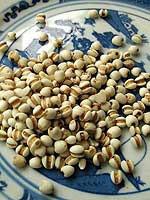Name
Latin Name: Semen CoicisCommon Name: Coix seed Scientific Name: Coix lacryma-jobi L. var. mayuen (Roman.) Stapf
Chinese Name: 薏苡仁Pinyin Name: yi yi ren
Origin
The mature kernel of Coix lacryma-jobi L. var. mayuen (Roman.) Stapf, a perennial herbal plant of the Graminae family. The medicinal part is used in raw or fired form.1
Where Does It Grow?
Coix seed is widely disturbed in China, it is mainly cultivated and produced in provinces like Fujian, Jiangsu, Hebei, and Liaoning. Nowadays, many provinces like Sichuan, Jiangxi, Hunan, Hubei, Guangdong, Guangxi, Guizhou, Yunnan, Shanxi and Zhejiang also produce this herb.1,5
Nature and Flavor
Coix seed is mild cold in nature, sweet and bland in flavor, and mainly manifests its therapeutic actions in the spleen and stomach and lung meridians.
2
Identified Active Components / Major Chemical Constituents
Active components in coix seed includes coixol, coixenolide, α-monoolein, feruloylstigmasterol, feruloylcampesterol, α, β, γ-sitosterol, α, β, γ-stigmasterol, benzoxazinones, idenes, triterpenoids, alkaloid, adenosine, coixan A-C, amino acids, vitamins B1 and violate oils.5,7

Drug Actions in TCM
Coix seed can promote body fluids redistribution, expel dampness, invigorate spleen, stop diarrhea, eliminate pain and swelling in limbs, clear heat and facilitate pus drainage.2
Traditional Uses in TCM
Traditionally, coix seed is often used to treat edema, nutritional foot symptoms, feverish conditions, internal abscess, urinary tract infections, diarrhea, vaginal discharges, painful joints and limbs, limb or muscular spasms. Modern TCM also uses it in cancers, diabetes, warts, and acne.3,4,5
Coix seed promotes fluid redistribution and expels dampness
For individuals with urinary difficulty and limb swelling, coix seed is indicated along with poria, polyporus, astragalus root and cassia twig. Besides redistributing body fluids and expelling dampness, the herb also provides essential nutrients and enhances body functions, and thus is a common ingredient for the above condition. Coix seed can be used in urinary frequency due to damp-heat irritating the lower burner, that it is used with talc and plantain seed in the remedy. In some infectious diseases, when the individual develops alternative fever and chills, body aching, frequent nausea or vomiting, coix seed can be used with bitter apricot seed, jave amonum fruit, pinellia tuber, and talc, which can eliminate dampness and clear heat.
Coix seed expels dampness and invigorates the spleen
Spleen deficiency can cause frequent episodes of diarrhea, coix seed (over 30g) is used along with pilose asiabell root, largehead atractylodes rhizome, poria, Chinese yam and hyacinth bean to invigorate the spleen. When the individual also presents with lumbar soreness, knee weakness, aversion to coldness, limb coldness, diarrhea at dawn, that means kidney yang deficiency is also involved, the remedy should add in psoralea and dodder seed to warm the kidney system.
Coix seed expels dampness, relieves bi syndrome , loosens tendons and facilitates blood circulation
Coix seed can work with herbs, such as notopterygium root, pubescent angelica root, clematis root and Sichuan lovage rhizome, to treat arthritis, limb spasm and joint moving difficulty, which are regarded as wind and dampness pathologies in TCM. For serious cases such as severe joint swelling and stiffness, the remedy should add in atractylodes rhizome and largehead atractylodes rhizome to enhance the dampness expelling power; when the individual has accompanied apparent lumbar soreness and knee weakness, then the remedy should add in mulberry mistletoe and Himalayan teasel root to invigorate the liver and kidney. For disharmony of wind and dampness attacking the superficial body, that present with body aching, fever, headache, fatigue, nausea, and irritability (intestinal flu symptoms), it is proper to use coix seed along with ephedra, bitter apricot seed, and liquorice root for relief. Weakness and wasting of foot muscles can be due to damp-heat irritation too, coix seed can work with atractylodes rhizome, amur corktree bark, and cyathula root to clear heat, expel dampness, strength the knee and feet.
Coix seed clears heat and facilitates pus drainage
Coix seed is often used in internal abscess. For example, it is used with wax gourd kernel, peach kernel and reed rhizome for lung abscess; when the abscess is ruptured that leads to vomit large amount of bloody sputum, the remedy should add in platycodon root, common bletilla tuber and wild buckwheat rhizome, to facilitate the pus drainage. Coix seed can be selected with peony root bark, peach kernel and patrinia herb to treat intestinal abscess.
Coix seed only has a gentle therapeutic effect, when it acts as a major ingredient in the remedy, a high dose (up to 30g) is usually indicated.
Pharmacological Actions
Research shows that coix seed can reduce inflammation, stop pain, lower fever, regulate blood sugar and pressure, relieve contacted muscle, enhance immunity, anti-cancer, regulate respiratory movement and induce ovulation.4,5,7
Toxicology
When mice were injected hypodermically with coix seed oil, the lethal dose was found to be 5~10mg/kg, while injected in rabbits, the lethal dose was found to be 1~1.5g/kg. When mice were administered by gavage with coixol 0.5kg for one month, no pathological change was found. Long-term clinical follow up showed coix seed decoction within the suggested dose has no adverse reaction, neither in high dose (above 30g) or as food consumed.4
Administration and Dosage
Orally, the usual dose is 10~30g, or up to 30~60g if necessary. Raw herb is suitable for clearing heat and expelling dampness; fried herb is suitable for invigorating the spleen and stop diarrhea. Besides medicinal use, coix seed is also a supreme healthy food, which is usually cooked as congee.2
Adverse Effect, Side Effects and Cautions
Those who have a weak stomach, or dry stools or pregnant should use with caution.6
References
- Li Jiashi (editor-in-chief), Chinese Medicine Identification, Shanghai Scientific and Technical Publishers, 2000-2.
- Lui Daiquan (editor-in-chief), Chinese Herbal Medicine, Shanghai Scientific and Technical Publishers, 2000-6.
- Tao Yufeng, Clinical Herbal Medicine, People’s Medical Publishing House, 2005-5.
- Chen Pian, Clinical Application of Tonifying Herbs, Second Military Medical University Press, 2008.
- Zhao Zhongzhen & Xiao Peigen (editor-in-chief), Contemporary Medicinal Herbal Glossary, Hong Kong Jockey Club Institute of Chinese Medicine, 2006-8.
- http://www.zysj.com.cn/zhongyaocai/yaocai_y/yiyiren.html
- http://www.360doc.com/content/10/1218/21/3306816_79351969.shtml



